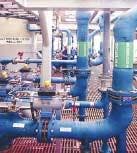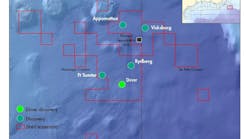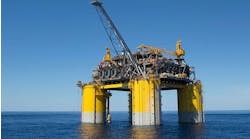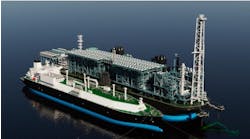Jerry Manning
Shell Mars TLP Utilities Team
Dick Lea
Kevin Schmit
EDO Specialty Plastics
After eight years in service, composite piping on Shell's Mars platform in the Gulf of Mexico has proven that it meets promises made years earlier. The effort has paid off in lowered weight, enhanced corrosion resistance, and cost savings, but the greatest value might have been gained in other lessons learned in applying composite piping to topside applications.
In the spring of 1995, installation of composite piping began on the world's second deepwater TLP at McDermott Fabricators in Amelia, Louisiana. This was the first application of composite piping in a firewater ringmain system the US Coast Guard approved.
Since the early 1950s, the oil and gas industry has known of the corrosion resistance of composite piping in seawater applications. Cut-outs taken from composite pipe systems after five and 10 years in service have shown little effect from seawater corrosion. Ultraviolet resistance has been controlled with the application of a UV inhibitor and gel coat. Fiber bloom, a surface phenomenon, has been eliminated with the use of a synthetic fabric in the pipe external corrosion barrier applied during manufacture. Other than surface fading of the firewater red gel coat where exposed to direct sunlight, the piping the project team installed on Mars is in excellent condition. Recently, the platform has begun to inject 1 to 5 ppm of sodium hypochlorite into the system to control marine growth. An inspection of the pipe system on Mars in 2001 estimated that Shell could expect a service life in excess of 30 years. Recently a major waterflood system was installed on Mars using Fiberbond pipe as the primary piping system.
Composite pipe
For Mars, Shell Deepwater USA selected composite pipe for the "wet" firewater ringmain pipe in accordance with US Coast Guard regulations, as well as various seawater systems. There are approximately 80,000 lb (36,288 kg) of composite pipe in sizes 4-12 in. installed in the original systems. If these same systems had used alloy pipe, the weight could have been 360,000 lb. The selection of composite pipe for the various seawater systems resulted in a topsides dead weight savings of up to 280,000 lb.
Composite piping is generally considered to be the lowest installed cost corrosion-resistant piping material that can be used in low pressure (<290 psig or 20 barg) and low temperature (<250° F or 121° C) seawater systems. Since the design life of major deepwater projects often exceed 30 years, common alloys like carbon steel and galvanized steel are usually not considered for the low pressure, low temperature seawater systems based on life-cycle cost.
null
While the benefits of composite piping in seawater applications are obvious to the corrosion engineer, dozens of installations demonstrate that the mechanical design engineer should approach these materials as specialty piping systems.
The proper design, assembly, and installation of composite pipe systems are complex. Since it is not a homogenous material, many factors play a role in proper system design. The piping team must design pipe supports, guides, and anchors in harmony with the composite piping system. Excessive water hammer should be avoided. Therefore, the project team must select the composite pipe supplier prior to detail design of the composite piping systems and treat the pipe supplier as an important design consultant for the specialty piping systems.
The supplier should be involved in all phases of design, assembly, and installation, plus included in any discussions with the certifying agency. The project team should not consider composite pipe systems a commodity piping system at this stage in the development of the technology.
Working closely with the Shell project team and the piping design engineers at Linder and Associates, New Orleans, Louisiana, EDO Specialty Plastics supplied details for supports, guides, and anchors; ran the system stress analysis; and was responsible for shop pre-fabrication and overseeing field installation. At McDermott's fabrication yard in Morgan City, Louisiana, the project team installed piping evaluated welds prior to field hydrotest. Approximately 260 welds were in the firewater system, and after bolt-up, the project team tested the system at 300 psig (20 barg) for one hour. Today, it is not unusual to install systems rated to 232 psig (16 barg) and tested to 348 psi (24 barg). Certified welding inspectors can perform simple evaluation procedures to insure weld reliability.
Deepwater activities require innovative solutions, thinking "outside the box," and close cooperation between operators, design engineering firms, fabricators, and suppliers. The use of plastic piping in firewater service has demonstrated exceptional performance characteristics, but composite piping is still considered an emerging technology.
Until there are competent composite piping engineers designing vital piping systems and trained certified mechanics fabricating and installing these materials, the best service life and application performance will probably be gained from composite piping suppliers that can provide single source responsibility and in-service warranty. Then, like the experience on Mars, the promise of improved corrosion resistance, weight savings, and installed cost will be fully demonstrated.




